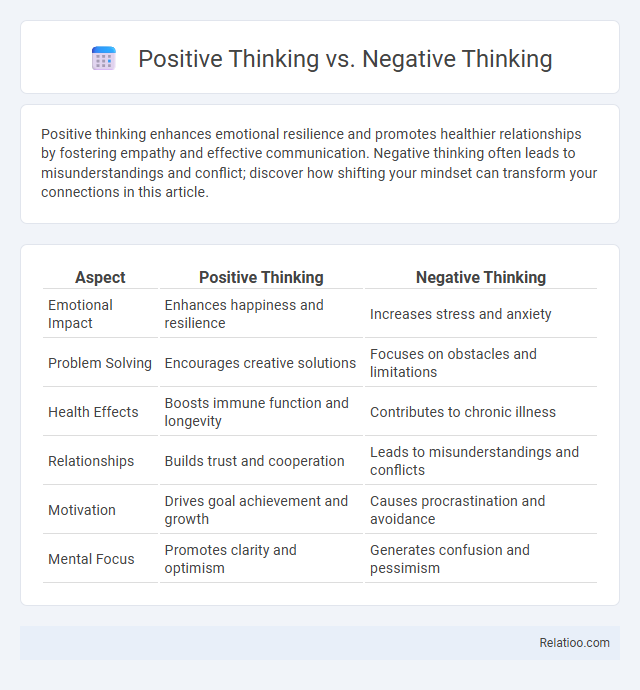Positive thinking enhances emotional resilience and promotes healthier relationships by fostering empathy and effective communication. Negative thinking often leads to misunderstandings and conflict; discover how shifting your mindset can transform your connections in this article.
Table of Comparison
| Aspect | Positive Thinking | Negative Thinking |
|---|---|---|
| Emotional Impact | Enhances happiness and resilience | Increases stress and anxiety |
| Problem Solving | Encourages creative solutions | Focuses on obstacles and limitations |
| Health Effects | Boosts immune function and longevity | Contributes to chronic illness |
| Relationships | Builds trust and cooperation | Leads to misunderstandings and conflicts |
| Motivation | Drives goal achievement and growth | Causes procrastination and avoidance |
| Mental Focus | Promotes clarity and optimism | Generates confusion and pessimism |
Understanding Positive Thinking: An Overview
Positive thinking involves focusing on constructive thoughts and expecting favorable outcomes, which can improve mental health and resilience. Negative thinking emphasizes pessimism and doubt, often leading to increased stress and decreased problem-solving ability. Positivity combines optimistic attitudes with practical actions, fostering overall well-being and enhanced coping strategies in challenging situations.
The Nature of Negative Thinking
Negative thinking often stems from cognitive biases such as catastrophizing or overgeneralization, which can distort your perception of reality and amplify stress. Unlike positivity, which encourages realistic optimism and growth, negative thinking traps the mind in a cycle of fear and doubt, limiting emotional resilience and decision-making effectiveness. Understanding the nature of negative thinking helps identify patterns that undermine your mental well-being and supports the development of healthier thought processes.
Key Differences Between Positive and Negative Thinking
Positive thinking emphasizes optimism, focusing on opportunities and solutions, while negative thinking concentrates on problems and potential failures. Positivity encompasses a broader mindset that includes constructive optimism, emotional resilience, and proactive behaviors, unlike negative thinking which often leads to stress and decreased motivation. Key differences lie in their impact on mental health, decision-making, and overall life satisfaction, with positive thinking promoting well-being and negative thinking contributing to anxiety.
Psychological Effects of Positive and Negative Thoughts
Positive thinking enhances your psychological well-being by reducing stress, improving resilience, and promoting a healthier immune system, while negative thinking increases anxiety, depression, and cognitive distortions. Positivity cultivates an optimistic mindset that supports emotional regulation and adaptive coping strategies, directly influencing mental health outcomes. Understanding the distinct psychological effects of positive and negative thoughts empowers you to foster healthier mental habits and improve overall life satisfaction.
How Positive Thinking Influences Mental Health
Positive thinking significantly improves mental health by reducing stress levels, enhancing emotional resilience, and promoting a proactive mindset toward challenges. Your brain releases fewer stress hormones and produces more endorphins when engaged in positive thinking, which supports better mood regulation and overall psychological well-being. Cultivating positivity helps reframe negative experiences, fostering healthier coping strategies and long-term mental wellness.
The Impact of Negative Thinking on Well-being
Negative thinking significantly undermines your well-being by increasing stress levels and impairing mental health, often leading to anxiety and depression. It triggers a cycle of harmful cognitive patterns that reduce motivation and resilience, making it harder to cope with daily challenges. Cultivating positivity helps counteract these effects by promoting emotional balance and enhancing overall psychological resilience.
Techniques to Cultivate Positive Thinking
Cultivating positive thinking involves techniques such as mindfulness meditation, gratitude journaling, and cognitive restructuring, which help redefine negative thought patterns and enhance emotional resilience. Practicing daily affirmations and engaging in solution-focused problem-solving foster an optimistic mindset that counters negativity and supports mental well-being. Incorporating physical exercise and social connections also promotes positivity by releasing endorphins and encouraging supportive interactions, reinforcing a constructive mental approach.
Overcoming Negative Thought Patterns
Overcoming negative thought patterns involves shifting from negativity bias to cultivating positive thinking through cognitive restructuring and mindfulness techniques. Positive thinking promotes resilience and mental well-being by reframing challenges as opportunities, while mere positivity without addressing underlying thoughts can lead to toxic positivity. Effective strategies include challenging irrational beliefs, practicing gratitude, and engaging in affirmations to foster authentic optimism and sustained emotional health.
The Role of Mindset in Success and Happiness
Positive thinking enhances your mindset by fostering resilience, motivation, and proactive problem-solving, which directly contribute to success and happiness. Negative thinking often limits potential through self-doubt and stress, hindering achievement and well-being. Positivity integrates realistic optimism with emotional balance, creating a sustainable approach that supports long-term success and personal fulfillment.
Embracing a Balanced Approach to Thinking
Embracing a balanced approach to thinking involves recognizing the impact of positive thinking, negative thinking, and genuine positivity on your mental well-being and decision-making. Positive thinking cultivates optimism and resilience, while negative thinking highlights potential risks and areas for improvement, ensuring that you are prepared for challenges. Your ability to blend these perspectives with true positivity fosters emotional balance, enhances problem-solving skills, and promotes realistic optimism in everyday life.

Infographic: Positive Thinking vs Negative Thinking
 relatioo.com
relatioo.com